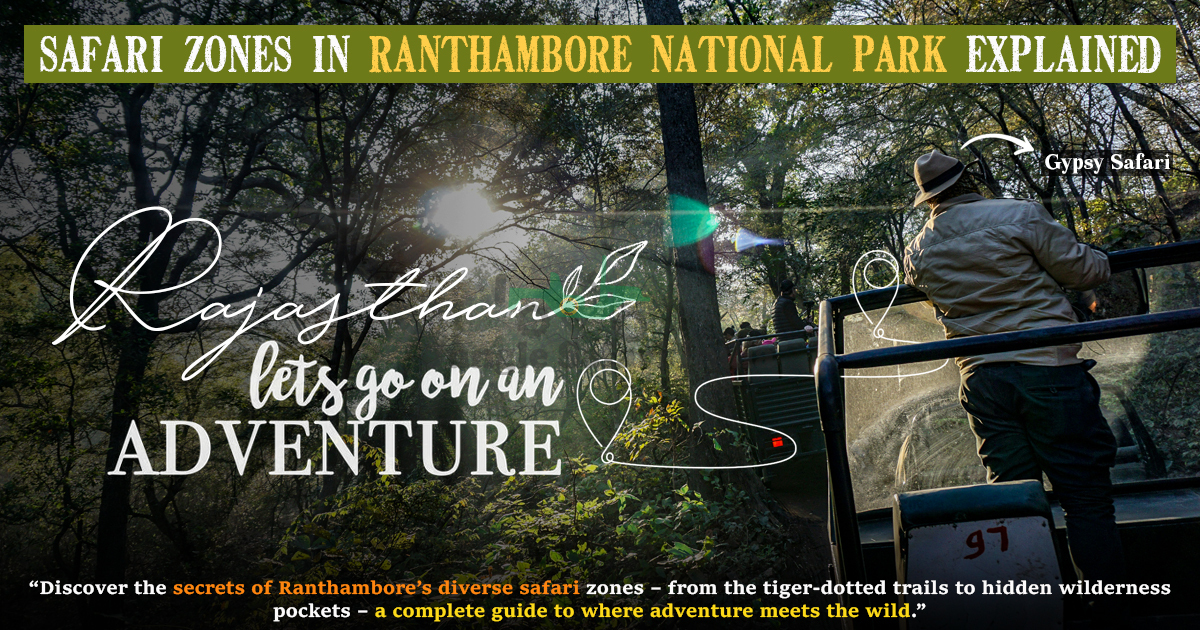Ranthambore in India is well known for Bengal tigers and many wild animal species. Many tourists visit each year to enjoy nature and wildlife. To manage safari trips better, the park is divided into 10 zones. Zones 1 to 5 are called core zones and are in the middle of the park. These zones often have more tiger sightings.
Zones 6 to 10 are buffer zones outside the core zones. Before, these were not given much importance, but now they also offer good chances to see tigers and other animals. All zones have wildlife like leopards, deer, sloth bears, and birds. Every zone is worth visiting.
How The Safari System Works
Safaris in Ranthambore National Park are managed by the Rajasthan Forest Department. This is done to protect the animals, control the number of vehicles, and make sure that no one gets an unfair advantage.
When a visitor makes a Ranthambore safari booking, the forest department uses a computer system to assign the safari zone. The system works randomly. This means no person can choose a zone on their own, and no one can pay extra money to get a special zone. The random system makes the booking process fair and equal for everyone.
After a zone is given to a vehicle, the safari gypsy or canter (open bus) must stay inside that particular zone. It cannot move to other zones during the safari. This rule is very strict, and it is followed to make sure the wildlife is not disturbed by too many vehicles.
Entry gates are not the same for all zones in the park.
- Zones 1 to 5 start from the main gate of Ranthambore National Park.
- Zones 6 to 10 start from another gate, which is on the other side of Sawai Madhopur city.
This system of separate entry points helps in dividing the visitors equally, so that no one area becomes too crowded. Every person who books a safari has the same chance of being assigned to any of the 10 zones.
Zones 1–5: Core Safari Areas
Zone 1
Zone 1 is close to the main entry gate. It is often called a transition zone because animals move in and out of it. Still, this zone has many tiger sightings. Inside this zone, places like Tuti Ka Nala, Sultanpur, and Singh Dwar are very famous. Tigers are often seen in these areas, and visitors find this zone exciting.
Zone 2
Zone 2 is one of the most liked zones of Ranthambore National Park. It has hills, valleys, & water sources, which are important for animals. Because of these features, tigers are often seen here. Many visitors who do a safari in Zone 2 come back with good sightings of tigers and other animals like leopards, jackals, & deer. That is why it is considered a top choice.
Zone 3
Zone 3 is very popular because of its natural beauty. The famous lakes, Padam Talab and Raj Bagh, are in this zone. These lakes attract tigers, crocodiles, deer, and birds, so wildlife viewing is very good here. Also, the Ranthambore Fort can be seen in the background, which gives an interesting historical view. Also, many photographers prefer this zone because of the lakes and good opportunities for tiger sightings.
Zone 4
Zone 4 has rocky areas, old ruins, and beautiful natural spots. This zone is linked with the memory of Machli, the legendary tigress of Ranthambore. She was once the main tiger here, and many visitors came specially to see her. Even today, this zone is famous for tiger sightings, and other wildlife is also commonly seen. The mix of natural land and old structures makes it special.
Zone 5
Zone 5 shares the entry point with Zone 4 but is less crowded. The zone is quiet & peaceful and has good opportunities for seeing tigers. Leopards are also found here, which makes it exciting for visitors. Many people who want a calm safari prefer Zone 5 because it is not very crowded but still rich in wildlife.
Zones 6–10: Buffer Safari Areas
Zone 6 (Kundal)
Zone 6, called Kundal, is close to Zone 1. It has wide grasslands and mountains in the background. Because it is close to the core area, tigers often move between Zone 1 and Zone 6. This makes tiger sightings possible here as well. The open land of Zone 6 also makes it easy to watch deer, antelope, and many other animals.
Zone 7 (Chidikho)
Zone 7 is a hilly area. It is not as busy as the core zones, so visitors can enjoy a quiet safari here. Tiger sightings are less regular compared to the central zones, but they still happen. Apart from tigers, many other animals & birds can be seen in this natural area. People who want fewer crowds often prefer Zone 7.
Zone 8 (Balas)
Zone 8, also called Balas, is similar to Zone 7 in landscape. It is also a hilly zone and is known for leopards. People who want to see other big cats apart from tigers find this zone interesting. It is different from the core zones and is quiet & calm. That makes it good for those who want a relaxed experience.
Zone 9 (Kuwal Ji)
Zone 9, also called Kuwal Ji, is far from the main part of the park. It runs along the Chakal River, which gives it a fresh & different environment. Visitors in this zone may see tigers, sloth bears, and sometimes even the rare caracal. Because this zone is away from the busy central part, it feels more isolated and special.
Zone 10 (Aantri)
Zone 10, also called Aantri, is one of the newer zones of Ranthambore National Park. It has hills, small lakes, and is very good for birdwatching. Birds like eagles, vultures, and kingfishers are often seen here. In the past few years, tiger sightings in Zone 10 have also increased, so now it is popular for both animals and birds.
Key Things To Remember
- All zones in Ranthambore National Park have animals, but tiger or other sightings are not fixed as animals move anytime.
- The core zones (1–5) are more famous for tiger sightings, so they often have high demand.
- The buffer zones (6–10) are also becoming very good for safaris. They now have regular tiger and leopard sightings.
- Sightings during safari depend on time and luck. Tigers are not always seen, but other animals & nature are always there.
- Ranthambore safari booking follows a fair system. No visitor or agent can change it, so all get an equal chance.

